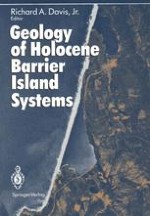1994 | OriginalPaper | Buchkapitel
The Georgia Bight Barrier System
verfasst von : Miles O. Hayes
Erschienen in: Geology of Holocene Barrier Island Systems
Verlag: Springer Berlin Heidelberg
Enthalten in: Professional Book Archive
Aktivieren Sie unsere intelligente Suche, um passende Fachinhalte oder Patente zu finden.
Wählen Sie Textabschnitte aus um mit Künstlicher Intelligenz passenden Patente zu finden. powered by
Markieren Sie Textabschnitte, um KI-gestützt weitere passende Inhalte zu finden. powered by
Analysis of the geomorphology and sedimentology of the shoreline of the Georgia Bight by compartment shows a systematic change of the barrier islands around the bight. Long barrier islands averaging 38 km in length that are morphologically wave-dominated and stratigraphically transgressive compose greater than 50% of the shoreline of the outer edges of the bight. Over 50% of the shoreline at the head of the bight is composed of short (~8 km), mixed-energy, regressive barrier islands that show downdrift offsets and drumstick configurations in plan view. The shorelines of the northern and southern flanks of the bight, which are positioned across the Cape Fear and Ocala tectonic arches, contain abundant welded barriers and barrier spits (24% of total shoreline of bight; most common shoreline type) that have narrow to nonexistent backbarrier systems.Tidal inlets, which increase markedly in abundance toward the head of the bight because the tidal range increases to more than 3 m in that area, play several important roles in the evolution of the barrier islands. The inlets have a major influence on erosional/depositional patterns of the islands as a result of their migrationary and sediment-storage characteristics. At the head of the bight, over 70% of the available Holocene sand is stored in large ebb-tidal deltas which serve as sediment sources and/or sinks for the barrier islands over time.Numerous studies of the stratigraphy of the Holocene barrier islands show that both regressive and transgressive barrier islands occur throughout the bight, with different types being located on opposite sides of the same tidal inlet in some instances. Local perterbations in sediment supply appear to determine the stratigraphic differences among these islands.The primary sediment sources for the barrier islands include directly from piedmont river systems, through reworking of Pleistocene barrier-island deposits by rivers and tidal channels, and alongshore sources from eroding mainland areas. Lobes of deltaic sediments deposited on the present continental shelf during lowered stands of sea level are thought to be important sediment sources for the islands in some areas.
